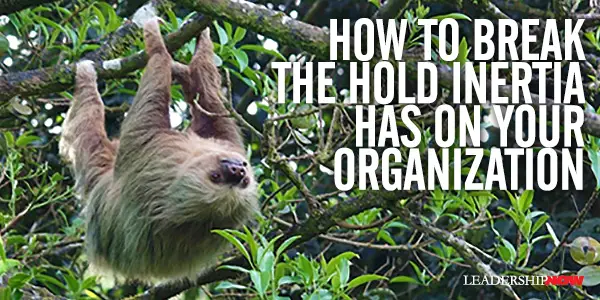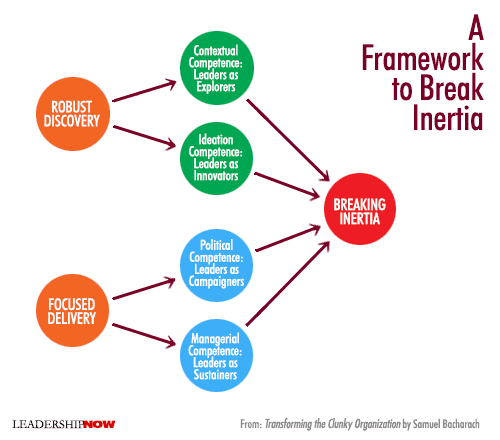 |
 |
08.20.18

How to Break the Hold Inertia Has on Your Organization
O In Transforming the Clunky Organization, Samuel Bacharach takes on the two fundamental sources of organizational inertia—the tendency to be clunky and the tendency to be myopic. The clunky organization is characterized by a state of organized anarchy. You’ll find overlapping structures, unclear decision processes, chaotic communication, and poor integration. This creates a general lack of focus. People are focused on their own activities but are not attentive to the activities of the whole. The clunky organization is missing the big picture. The myopic organization is characterized by an addiction to their past successes and behaviors, as a result, they find it difficult to make adjustments. “While they can adapt and improve, they do so by making repetition-based improvements.” Which type of inertia are you facing? It's probably not either/or. Most organizations face a little of both and it can vary from one organizational issue to the next—one department to the next. There are some questions you can ask to conduct a self-assessment. Questions related to the clunky organization would include: Are the business units integrated? Are the lines of decision-making authority clear? Is there ambiguity or a lack of goal alignment? Do competing agendas lead to turf and silo issues? Questions related to the clunky organization would include: Is the organization driven by one product or mindset? Is there centralized control of organizational mission and processes? Is it difficult to convince others to explore new directions or new opportunities? Is there a risk-adverse mind-set? Great leaders break inertia because they know that in order for an organization to thrive and reach their potential they must “engage in robust discovery and focused delivery” as a way of life. In other words, they must be able to read the signals and take action to bring those innovations to life. Engaging in robust discovery and focused delivery requires certain skills on the part of the leader as outlined below:  Robust Discovery To assure robust discovery, leaders must master the contextual competence of explorers and the ideational competence of innovators. To explore, they must scan the environment for useful information, read signals, and create partnerships. … Leaders who are innovators take steps to move an idea to germination. As an explorer, a leader looks for signals that the organization needs to adjust or to move in a new direction. Leaders should not just be scanning the familiar sources, but should also diversify the content they consume on a daily basis. If not, the tendency is to simply reinforce what we think we already know. Some signals need to be acted on immediately, others need to be thought through. “A strong signal elicits a question: What needs to be done? The weak signal asks, What does this mean?” Then those signals need to be transformed into an agenda. If you can see where a change needs to be made but can’t translate that into an actionable concrete agenda, a leader can actually drive their organizations into sluggish territory. Focused Delivery To assure focused delivery, pragmatic leaders must master the political competence of campaigners and the managerial competence of sustainers. …To engage in focused delivery, leaders must have the political competence to overcome the headwinds of resistance that sabotage forward movement and have the managerial competence to overcome challenges that could lead to dropping the ball. The important second half of the solution to breaking inertia in your organization is implementing the new agenda and seeing it through to get the desired result. “Leaders in sluggish organizations may have impeccable discovery, but they may stumble when it comes to making those good ideas a reality.” And then there’s the resistance. Ideas themselves are rarely threats. But “the moment that a specific idea shows concrete potential, the forces of resistance jump into action.” A leader must know where other people are coming from. “In clunky organizations issues of turf, transaction costs, and fear of losing power can lead to resistance. When the myopic tendency is in play, the fear of losing face or the security that comes from habit will cause many leaders to retreat into accepted business models and the old ways of doing things to preserve some semblance of safety.” It’s a fact that old game-changing agendas can become the new organizational pattern leading to inertia—the sluggish, myopic organization. Leaders must always be willing to seek out signals that old agendas need to be changed to regain organizational momentum. 
Posted by Michael McKinney at 08:30 AM
|
BUILD YOUR KNOWLEDGE
 

How to Do Your Start-Up Right STRAIGHT TALK FOR START-UPS 
Grow Your Leadership Skills NEW AND UPCOMING LEADERSHIP BOOKS 
Leadership Minute BITE-SIZE CONCEPTS YOU CAN CHEW ON 
Classic Leadership Books BOOKS TO READ BEFORE YOU LEAD |